#slavic goddess
Text
how much parents issues do you need to ask literal ancient gods if theyre proud of you asking for a friend
#pagan#paganism#witchcraft#deity work#greek gods#aphrodite#aphrodite devotee#bastet#bastet devotee#apollo#apollo devotee#dionysus#dionysus devotee#marzanna#morana#morana devotee#slavic goddess#hellenic deities#hellenic polytheism#kemetic#kemetism
292 notes
·
View notes
Photo
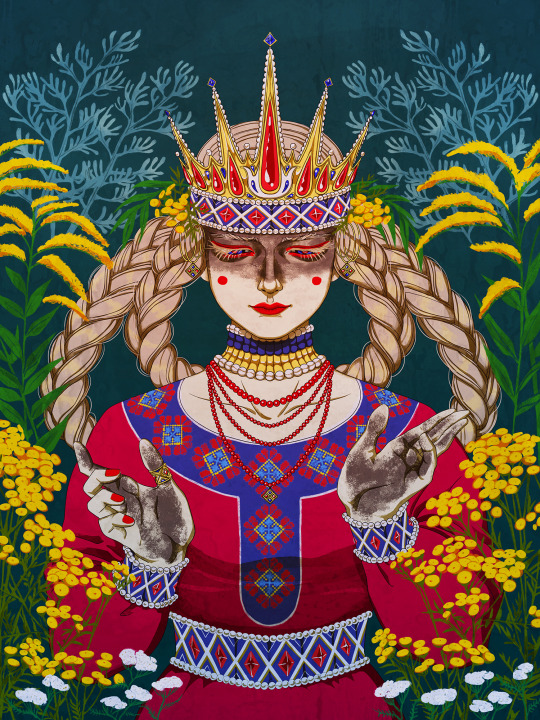
Mokosh, the Mother Earth, the Slavic goddess of fertility and harvest.
Prints are available HERE
Follow me on IG: @aga_futa
#slavic#slavic mythology#slavic folklore#Slavic Goddess#mokosh#mokosz#mokosza#polish#my art#personal#digital art
2K notes
·
View notes
Photo

Karolina Matyjaszkowicz — “Mokosh” The Mother Earth (acrylic on canvas, 2017)
283 notes
·
View notes
Text

Hiii guys. Today I can show you Dodola - the goddess of rain and light thunderstorms, warm showers and fertility. She is one of the most beautiful and kind goddesses of Iriy (the place where the light gods live). It is very difficult to anger her, but if this happens, then be careful. She is Perun's wife, the mother of Devana and Yarilo (I haven’t drawn him yet).
I didn't think about giving her any important role in the story, but after I drew her I started thinking… Because she turned out so cute and cool wah haha
#folk tales#slavic mythology#slavic#artist on tumblr#character design#digital art#comics#tales of lukomorye#character concept#slavic folklore#dodola#goddess#slavic goddess
29 notes
·
View notes
Text
There are seven primordial gods in Slavic mythology, and only one of them is female: Mokosh. In the pantheon in the Kievan Rus' state, she is the only goddess at all, and so her specific role in Slavic mythology is vast and varied, and, more aptly perhaps, foggy and damp. Mother earth and house spirit, tender of sheep and spinner of fate, Mokosh is the supreme Slavic goddess.
Key Takeaways: Mokosh
Associated Deities: Tellus, Ziva (Siva), Rusalki (water nixies), Lada
Equivalents: St. Paraskeva Pianitsa (Christian Orthodox); loosely comparable to the Greek Titan Gaia, Hera (Greek), Juno (Roman), Astarte (Semitic)
Epithets: Goddess Who Spins Wool, Mother Moist Earth, Flax Woman
Culture/Country: Slavonic Culture, Eastern and Central Europe
Primary Sources: Nestor Chronicle (a.k.a. Primary Chronicle), Christian-recorded Slavic tales
Realms and Powers: Power over the earth, water, and death. Protector of spinning, fertility, grain, cattle, sheep, and wool; fisherman and merchants.
Family: Wife to Perun, lover to Veles and Jarilo
Mokosh in Slavic Mythology
In Slavic mythology, Mokosh, sometimes transliterated as Mokoš and meaning "Friday," is Moist Mother Earth and thus the most important (or sometimes only) goddess in the religion. As a creator, she is said to have been discovered sleeping in a cave by a flowering spring by the spring god Jarilo, with whom she created the fruits of the earth. She is also the protector of spinning, tending sheep, and wool, patron of merchants and fishermen, who protects cattle from plague and people from drought, disease, drowning, and unclean spirits.
The origins of Mokosh as mother earth may date to pre-Indo-European times (Cuceteni or Tripolye culture, 6th–5th millennia BCE) when a near-global woman-centered religion is thought to have been in place. Some scholars suggest she may be a version of Finno-Ugric sun goddess Jumala.
In 980 CE, Kievan Rus emperor Vladimir I (died 1015) erected six idols to Slavic gods and included Mokosh in 980 CE, although he took them down when he converted to Christianity. Nestor the Chronicler (11th century CE), a monk at the Monastery of the Caves in Kyiv, mentions her as the only female in his list of seven gods of the Slavs. Versions of her are included in the tales of many different Slavic countries.
Appearance and Reputation
Surviving images of Mokosh are rare—although there were stone monuments to her beginning at least as long ago as the 7th century. A wooden cult figure in a wooded area in the Czech Republic is said to be a figure of her. Historical references say she had a large head and long arms, a reference to her connection with spiders and spinning. Symbols associated with her include spindles and cloth, the rhombus (a nearly global reference to women's genitals for at least 20,000 years), and the Sacred Tree or Pillar.
There are many goddesses in the various Indo-European pantheons who reference spiders and spinning. Historian Mary Kilbourne Matossian has pointed out that the Latin word for tissue "textere" means "to weave," and in several derivative languages such as Old French, "tissue" means "something woven."
The act of spinning, suggests Matossian, is to create body tissue. The umbilical cord is the thread of life, transmitting moisture from the mother to the infant, twisted and coiled like the thread around a spindle. The final cloth of life is represented by the shroud or "winding sheet," wrapped around a corpse in a spiral, as thread loops around a spindle.
Role in Mythology
Although the Great Goddess has a variety of consorts, both human and animal, in her role as a primary Slavic goddess, Mokosh is the moist earth goddess and is set against (and married to) Perun as the dry sky god. She is also linked to Veles, in an adulterous manner; and Jarilo, the spring god.
Some Slavic peasants felt it was wrong to spit on the earth or beat it. During the Spring, practitioners considered the earth pregnant: before March 25 ("Lady Day"), they would neither construct a building or a fence, drive a stake into the ground or sow seed. When peasant women gathered herbs they first lay prone and prayed to Mother Earth to bless any medicinal herbs.
Mokosh in Modern Usage
With the coming of Christianity into the Slavic countries in the 11th century CE, Mokosh was converted to a saint, St. Paraskeva Pyanitsa (or possibly the Virgin Mary), who is sometimes defined as the personification of the day of Christ's crucifixion, and others a Christian martyr. Described as tall and thin with loose hair, St. Paraskeva Pyanitsa is known as "l'nianisa" (flax woman), connecting her to spinning. She is the patroness of merchants and traders and marriage, and she defends her followers from a range of diseases.
In common with many Indo-European religions (Paraskevi is Friday in modern Greek; Freya = Friday; Venus=Vendredi), Friday is associated with Mokosh and St. Paraskeva Pyanitsa, especially Fridays before important holidays. Her feast day is October 28; and no one may spin, weave, or mend on that day.
Sources
Detelic, Mirjana. "St. Paraskeve in the Balkan Context." Folklore 121.1 (2010): 94–105.
Dragnea, Mihai. "Slavic and Greek-Roman Mythology, Comparative Mythology." Brukenthalia: Romanian Cultural History Review 3 (2007): 20–27.
Marjanic, Suzana. "The Dyadic Goddess and Duotheism in Nodilo’s the Ancient Faith of the Serbs and the Croats." Studia Mythologica Slavica 6 (2003): 181–204.
Matossian, Mary Kilbourne. "In the Beginning, God Was a Woman." Journal of Social History 6.3 (1973): 325–43.
Monaghan, Patricia. "Encyclopedia of Goddesses & Heroines." Novato CA: New World Library, 2014.
Zaroff, Roman. "Organized Pagan Cult in Kievan Rus’. The Invention of Foreign Elite or Evolution of Local Tradition?" Studia Mythologica Slavica (1999).
33 notes
·
View notes
Text
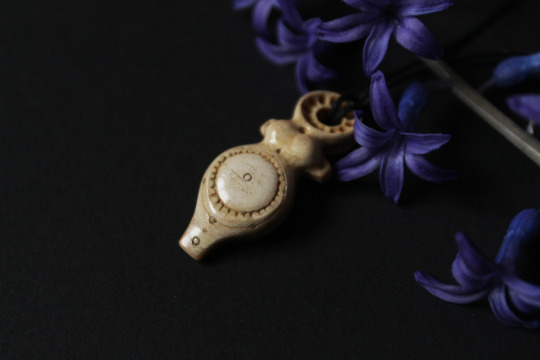





Handcarved pendant Berehynya
Made of mummoth tusk
#handcarving#bone carving#mummoth tusk#mummoth tusk curving#slavic goddess#slavic jewelry#bone jewelry#the mountain smoke
7 notes
·
View notes
Photo
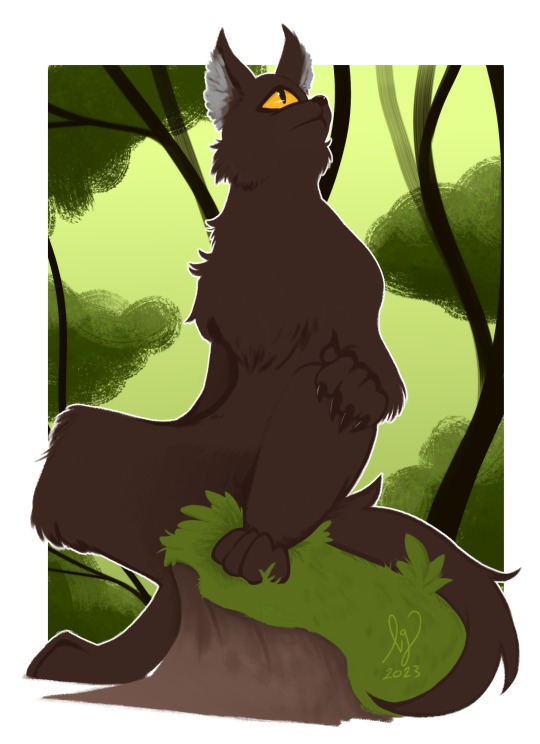
COMMISSIONS - KO-FI - CARRD - WEBSITE - REDBUBBLE SHOP - TWITTER - INSTAGRAM - YOUTUBE
.
Pasoglavac, keeping watch.
Finally finished this one, it’s a part of the same series as Vitorog and Lešij! Soft and line-less still.
I’ve had this design of Pasoglavac for a while now - using a Croatian Shepherd as a reference to make the very first drawing of him back in 2014. He remains one of my favorites.
This design is available in my Redbubble Shop
.
#soft art#digital art#illustration#digital painting#pasoglavac#slavic mythology#slavic folklore#Slavic Goddess#creature design#character design#animal character#mythology#mythological animal#neragranic#animal art#slavic myth
3 notes
·
View notes
Text
Marzanna: If I see a bug, I simply leave the room elegantly and require someone else do something about it.
Marzanna: If no one fulfills my wish, I simply never go back in there.
#tw bugs#queue#mythology#slavic mythology#incorrect quotes#source: perchance generator#slavic gods#slavic goddess#marzanna
15 notes
·
View notes
Text

This is Morana
Slavic goddess of war and winter
Linocut 30x42 cm format
Work created especially for the exhibition 'Parles moi d'Elle' at the Aérochrome in Blagnac
#slavic goddess#slavic folklore#linocutart#linocutartist#printmaking#linoprint#engravingart#magical art
2 notes
·
View notes
Text
before i started my deity work with Aphrodite i prayed to her to make me look like my best self and the day after that my hair started to curl randomly (i have no one in the family with curly hair) and i came out as genderfluid and i still was skeptical
then she gave me so many signs
i literally smelled apple chupa chups when i fell asleep (i didnt have anything apple scented in my room and the window was closed)
i was getting angel numbers constantly
i found a literal shell necklace when i went to throw the trash out
and i was still like "nah cus what if its a misunderstanding"
my soulmate was like "bitch youre so oblivious shes literally calling to you about your cars extended warranty"
and so i asked "if Aphrodite is reaching out to me please show me yourself in my dreams"
AND GUESS WHAT
i dreamed about watching a youtube video called "working with Aphrodite: deity work 101" and there was such a beautiful woman in the video she had a dark skin and long black wavy hair and very thick eyebrows and plump lips and i woke up and i was like "wow she was so pretty" and i was STILL skeptical cus i was like "nah maybe its just because i was thinking about her so much" and my soulmate was FED UP with my dumb bitch shit
and so it was time to do a deity spread because you know maybe its okay and if not then well
and i found a deity spread (i now make my own)
i pulled the card
it was nine of pentacles
i checked the deities associated with the card
"oh, thats random"
another deity spread
the strenght
"oh its the same deity"
ok i think somethings not adding up
and then i researched Bastet
"hmm cats yes, oh dancing,hmmm yeah okay"
and i looked at past me crying randomly because i got the urge to get a cat
and i looked at past me smelling incense randomly
and i looked at past me getting literal signs from her for as long as i could and i was like
"oh my god im so sorry i didnt know"
and so i started my deity work with both of them the same night
past me is stupid, oblivious and made mistakes but past me got me to now where i have a happy established relationship with my goddesses and im forever thankful for that
their altars at first were just sitting on my plant shelf
it was messy
Bastet only had my old silver cat statue, my cat tarot deck (which btw shows her character perfectly) and some tigers eye and tourmaline
Aphrodite only had some rose quartz a drawing of her that i made and a pale pink candle
now we're here and their altars are always full of food offerings to the point i had to upgrade their space to the shelf above
they still share an altar but theyre both okay with it
so uh yeah
just wanted to share this weird story of how i started
(then Aphrodite invited Apollo to my space who helped me a lot with my trauma, then i reached out to Dionysus and Marzanna and now we're here 5 ancient gods sitting in my room watching me read gay fanfiction at night)
#pagan#paganism#witchcraft#deity work#greek gods#aphrodite#aphrodite devotee#bastet#bastet devotee#hellenic goddesses#hellenic deities#hellenic pagan#hellenic polytheism#hellenism#kemetism#kemetic#egyptian goddess#apollo#apollo worship#apollo devotee#dionysus#dionysus devotee#marzanna#morana#morana devotee#slavic goddess
155 notes
·
View notes
Photo
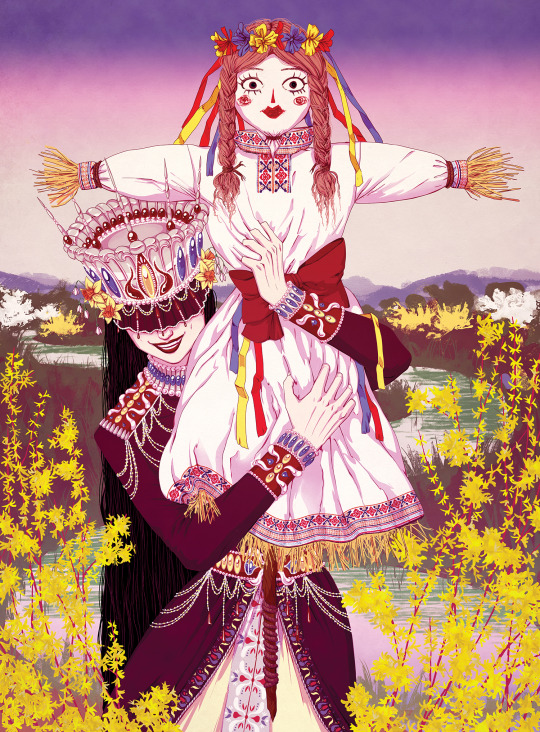
Marzanna (or Morana, Morena), the Slavic goddess of death, winter and rebirth. She's holding an effigy of herself, which is customarily drowned in Slavic cultures to bring about spring. This is one of those rare instances when I was able to draw something exactly the way it appeared in my head! Talk about divine inspiration, hopefully she likes it as much as I do 😂
YOU CAN GET PRINTS HERE
IG: @aga_futa
#my art#personal#marzanna#morana#morena#slavic#slavic goddess#pagan#digital art#polish#slavic folklore
1K notes
·
View notes
Text
небрежные воспоминания
значится, макошь связана с параскевой пятницей.
и ту не просто так зовут пятницей. все женские главные богини плодородия и семейного очага, защительницы женщин имеют свой покровительствующий день недели и это пятница.
а все языческие боги впоследствии переплетались со святыми.
кроме того макошь связана с русалками.
не помню как, но:
русалки, сидя на деревьях расчёсывают свои волосы, что являются символом женской энергии, силы, а сие отсылает к макоши. плюсом из-за этого мокошь связана с водой и колодцами. которые в свою очередь являются началом и поддержкой жизни, что также отсылает к макоши.
4 notes
·
View notes
Photo

Helloooooooo! Continuing to make character concepts. This is Devana, the goddess of hunting and forest animals (Greek Artemis). The most willful goddess in slavic mythology.
#slavic#slavic mythology#folk tales#comics#character design#slavic goddess#digital art#tales of lukomorye#slavic folklore#goddess of hunting#devana#artist on tumblr
48 notes
·
View notes
Text
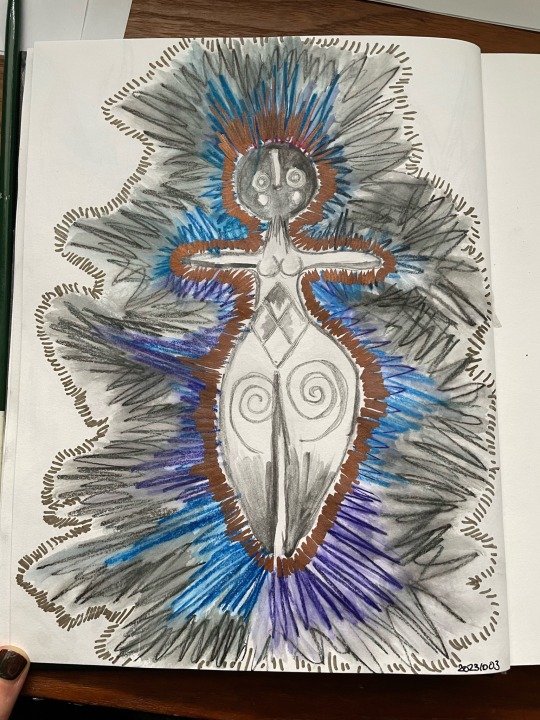
2023.10.03
Trypillian goddess
Prompts
1 note
·
View note
Photo



Am I back on Tumblr? Let’s find out!
By the way, I am doing a preorder for a new book, 31 Slavic Beings of Myth & Magic, an Illustrated Folklore book. Check it out on my ETSY! 🖤💀🌿

0 notes
